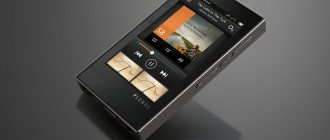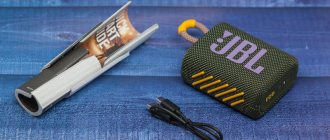Packaging and delivery
All three players come in crisp cardboard boxes. You can distinguish the models using the print on the reverse side. The contents look presentable; in the first compartment there is a player, in the second there is a microUSB cable. There are no questions about the quality of the latter, but the set could be richer.
Battery replacement
Sooner or later, batteries tend to degrade. After googling, I found out that the following model is required: CS-CWD2SL
.
It is best to buy from one “little-known” Chinese site, and not from local ones - it will be faster and cheaper.
The player is not easy to disassemble, but very simple. You need to unscrew 3 screws. Rear 2 and 1 from the end:
Removing the cover:
And disconnect the battery:
Nothing fancy. No tricky screws or loose batteries.
Appearance and ergonomics
The design of Plenue D is typical for Hi-Fi players - a small but dense black block. It looks heavy, but feels light, since the weight of the structure is only 94 grams. The secret is in the materials, only the back cover and the stylized top end are metal. The remaining edges are plastic.
Plenue J is similar in format to a smartphone, only very compact. The case is built on an aluminum frame, the back cover is made of unusual ribbed plastic. The musical orientation of the device is hinted at by the 3.5 mm jack, enhanced by the thickening of the case. Plenue J weighs 78 grams and fits easily into any pocket.
Plenue V received the most unusual design; the wedge-shaped body made of bright red aluminum stands out from its peers. The back cover is made of black soft-touch plastic with a complex shape that contrasts well with the rest of the surfaces. For fans of calm colors, the ordinary silver option is suitable. At its thickest it’s 17 mm, but the slope does its job and the player fits perfectly in a jeans pocket.
The trio uses a 2.8-inch IPS matrix with a resolution of only 320 by 240 pixels. The pixel density is 135 PPI, not a record, but the main requirements for the display are readability and economical battery consumption. The screen fully corresponds to this. The sensor is capacitive and responds to touches as expected.
The set of keys is identical: power, switching tracks and adjusting volume. Among the characteristic features, the Plenue D has a power button with a built-in indicator, stylized as an adjustment knob. The Plenue V has the same button hidden in the logo on the back cover. The list of interfaces includes: microUSB and standard 3.5 mm audio output. The players are compatible with microSD memory cards up to 128 GB.
Eastern minimalism and asceticism
Fifteen years ago it seemed that the era of MP3 players was here to stay.
That these humble gadgets ushered in a new era. However, even the once mighty iPod quickly fell before the brutal versatility of the modern smartphone. However, there are still people who want sound quality that no smartphone can give them. This is for them - Colorful, Hifiman and Astell&Kern produce their premium devices. Cowon also decided to keep up with its competitors and so today I will tell you about their latest product – Cowon Plenue M
From the first seconds the player fell into my hands, I had a feeling of respect for it. This is Korean. In the good sense of the word. Small, dignified and well mannered. At the same time, in an oriental way, it is modest and discreet. Cowon's main motive is discreet practicality coupled with solidity.
The metal body fits very nicely and confidently in the hand. I was very pleased with the screen. Firstly, it is bright, and secondly, it is very tactile and responds well to the touch of the fingers. The software design is concise. I was especially pleased with the presence of two sound pressure indicators, stylized as amplifier arrows. I remember these from SPL Phonitor. It looks very nice, studio style. They somehow reminded me of the cute robot Wall-E from the masterpiece Pixar cartoon.
The power button is located on the top panel of the device. The main control keys – Play\Pause, volume and track switching are located on the right side. It is convenient to press with your thumb without removing the player from your jacket pocket. The screen itself is 3.7 inches - perhaps the ideal size so that the menu is readable and controls can only be used with the thumb of the right hand. In short, it’s terribly convenient.
I was very pleased with the menu. For me personally, it was intuitive and did not pose any unnecessary puzzles for my brain. several “skins” to choose from, the ability to sort the media library by various parameters, such as Artist, album name, etc. Simple, tasteful and nothing extra.
Shell and functionality
A few years ago, COWON used Android in its flagship players. But the green robot is known for its merciless attitude towards the battery, which is unacceptable in Hi-Fi players that must play lossless formats for as long as possible. As a result, the company created its own base operating system based on the Linux kernel.
All our heroes have the same shell, so let’s look at the interface using Plenue D as an example. The firmware is Russified, the response is normal, but I would like more speed. Home screen - music player supports 2 skins and full screen mode. A nice feature is viewing the lyrics of the songs. The playback sequence and repeat of tracks are flexibly configured.
Tracks are grouped by album, artist, genre and year of recording. Your favorite songs can be collected into a separate playlist, and you can add several songs at once. To search for a specific song, you can use the keyboard, but there is no Russian one among them. Cyrillic tags and symbols are fully supported.
It's a pity that there is no Bluetooth support. It would be impossible to talk about Hi-Fi in this case, but modern Bluetooth codecs offer decent sound encoding quality.
Installing Rockbox
As written above, this is free firmware for multimedia players.
Official website: https://www.rockbox.org/. It is installed next to the standard one by modifying the bootloader.
First of all, we download the sources from GitHub (I do all this from my favorite Debian stable):
$git clone 'https://github.com/Rockbox/rockbox' Install the dependencies necessary to build the toolchain: #apt install build-essential texinfo libtool-bin flex bison Build the toolchain: #tools/rockboxdev.sh Download directory : /tmp /rbdev-dl (set RBDEV_DOWNLOAD or use —download= to change) Install prefix : /usr/local (set RBDEV_PREFIX or use —prefix= to change) Build dir : /tmp/rbdev-build (set RBDEV_BUILD or use —builddir= to change) Make options : (set MAKEFLAGS or use —makeflags= to change) Restart step : (set RBDEV_RESTART or use —restart= to change) Target arch : (set RBDEV_TARGET or use —target to change) Select target arch: s — sh (Archos models) m - m68k (iriver h1x0/h3x0, iaudio m3/m5/x5 and mpio hd200) a - arm (ipods, iriver H10, Sansa, D2, Gigabeat, etc) i - mips (Jz47xx and ATJ-based players) r - arm-app (Samsung ypr0) x - arm-linux (Generic Linux ARM: Samsung ypr0, Linux-based Sony NWZ) y - mips-linux (Generic Linux MIPS: AGPTek Rocker) separate multiple targets with spaces (Example : “sma” will build sh, m68k and arm) And select option “a”. Next will be the process of downloading and assembling the toolchain. This will all be located in /usr/local, unless a different prefix is specified. However, you can put it in a separate directory inside /opt, practice with checkinstall, or even assemble a full-fledged package.
After some time, the toolchain is ready. We assemble the patcher:
$cd rbutil/mktccboot; make && cd - The output is in the rockbox/rbutil/mktccboot/mktccboot directory, which we will use to build the bootloader. $mkdirbuild; cd build; ../toold/configure && make In the list, select item “33”, and then item “B” (Bootloader). The assembly process is in progress. The output is the file “bootloader-cowond2.bin”
Unpack the official firmware:
$unzip D2_2.59.zip And patch: $../rbutil/mktccboot/mktccboot D2_2.59/1/d2N.bin bootloader-cowond2.bin d2n.bin OF entry point: 0x2000006c New entry point: 0x203204fc Voila, we get the file d2n.bin, which we copy to the player’s internal memory. We disconnect the player from usb, turn it on, a short firmware process, and you're done.
Then we can assemble the rockbox itself using the same method (by selecting the “N” option):
$tools/configure && make && make zip Or download the finished one from the site: wget 'https://build.rockbox.org/data/rockbox-cowond2.zip' We put the directory of the assembled or downloaded firmware onto the memory card (after unpacking it). In my case (I prefer to use a card reader): cp -r .rockbox /media/sdb1-usb-Mass_Storage_Dev We put the memory card in the player and get our free and fully functional firmware.
Sound
Judging by the description, Plenue D and Plenue J are based on the same 24-bit DAC. But their characters are very different. Thus, Plenue D is distinguished by a powerful sound, rich in bass and rich mids; the highs fade into the background a little against this background. The accuracy is at a decent level, the player's hardware gives the sound characteristic features that will appeal to fans of driving genres.
The character of Plenue J , on the contrary, is shifted in favor of high frequencies and even deeper mids. The bass, as such, fades into the background, since all the listening attention is concentrated around the gorgeous, overly voluminous stage. It seems that the distance to each source is exact. Detailing is biased towards the mid and high ranges. The color of the sound will appeal to fans of acoustic genres filled with vocals.
Plenue V based on a completely different elemental base, namely, the Cirrus Logic CS43131 . The player is characterized by smooth sound, the same as it was laid out in the recording studio. The accuracy is maximum, each sound feels verified and worked out. At the same time, the width of the stage is between the previous models. Plenue V can be adjusted with an equalizer to suit any genre and expectations, while the picture remains just as accurate and sophisticated.
It's worth noting that they all outperform non-specialized devices, be they regular smartphones or MP3 players, and the difference is very noticeable. The above description is primarily required to compare today's trinity. In terms of sound character, COWON offers a proprietary JetEffect 5 equalizer with 48 presets, three of which can be customized to your taste. The BBE algorithm and a series of profiles based on it deserve special attention. The technology is designed to equalize sound characteristics to the level of live sound.
All players support playback of the main formats: MP3, FLAC up to 192 kHz / 24 bit, various variations of ALAC up to 192 kHz / 24 bit, WAV up to 192 kHz / 32 bit and others. Plenue V, due to more advanced hardware, is capable of playing DSD up to DSD128. The latter is the highest quality of all modern digital formats without compression.
Review of audiophile portable media players Cowon Plenue R and Plenue J
Today we will look at two models of portable media players manufactured by Cowon. These are new products on the market, Plenue R and Plenue J. They are a continuation of the popular Plenue series, which the manufacturer has been developing and producing for many years.
We scoured the entire Internet to understand where the word “Plenue” came from in the names of the players. There is no such word in English, French, or any other language. And for some reason no one asked this question; Google is stubbornly silent. The solution was found unexpectedly. If you remember that the manufacturer is from South Korea, and write the word Plenue in Hangeul 플레뉴 (read “plenyu”), then everything immediately becomes clear. The literal translation from Korean is “new player.” The name Plenue appeared at the time of the release of the D3 model and was first used by the company as a hint that it was an Android player. But later the word Plenue came to mean simply the entire line of high-quality audiophile Cowon players. Currently, the company's players are based on Linux, which gives long battery life, quick switching on and off, and higher quality sound, since there are no internal OS mixers.
Cowon Plenue R
Plenue R was announced in August 2022. This is the first player with Bluetooth in the company's line of audiophile models. In terms of positioning, it stands between Plenue D and Plenue M. The same can be said about the sound: it is approximately located between the mentioned models.
Specifications
| Name | Plenue R |
| Memory | built-in 128 GB, microSD up to 256 GB |
| Display | 3.7″ AMOLED, touch, 480×800 |
| Dimensions | 62×113×14 mm |
| Weight | 154 g |
| Frame | durable metal |
| Buttons | Power, Play/Pause, Vol+, Vol−, FF, Rew, multi-function button |
| CPU | ARM Cortex-A9, 2 cores, 1.2 GHz |
| Bluetooth | 3.0, support for A2DP and AVRCP profiles, SBC and aptX codecs |
| Track information | CUE Sheet, SACD ISO (2ch) |
| Lyrics | LRC, LDB, Lyrics3, ID3 Tag Lyrics |
| JetEffect 7 | 66 presets (50 factory + 16 user) EQ (10 band equalizer) BBE+ (BBE, Mach3Bass, 3D Surround, MP Enhance) optional (Chorus (8 modes), Reverb (9 modes)) |
| average price | find out prices |
| Retail offers | find out the price |
Official page of the Cowon Plenue R model
The Plenue R player has a new proprietary equalizer, JetEffect 7, which offers the user 66 presets and proprietary BBE+ technologies. That is, in terms of sound processing capabilities, the model is in no way inferior to flagship players with a three times higher price (Cowon Plenue 2 Mark II).
| Supported Formats | DXD / DSD (DFF, DSF) / FLAC / WAV / AIFF / ALAC / APE / MP3 / WMA / OGG / WV / TTA / DCF |
| DXD | 352.8/384 kHz |
| DSD | 5.64 MHz (DSD64, DSD128) |
| FLAC, WAV, AIFF, ALAC, WV (WavPack), TTA | 24 bit/192 kHz 352.8/384 kHz FLAC, WAV 32 bit float WAV, WAV tags downmix 5.1ch |
| MP3 | MPEG 1/2/2.5 Layer 3, 320 Kbps |
| WMA | 320 Kbps, 48 kHz |
| A.P.E. | Fast, normal, high compression rates (24 bit/192 kHz) |
| OGG | Q10, 44.1 kHz |
In terms of format support, everything is very good here. Any files up to 384 kHz and up to DSD128 are reproduced.
| DAC | TI PCM5242 |
| Signal/noise | 123 dB |
| KG | 0,001% |
| Channel penetration | −132 dB unbalanced / −134 dB balanced |
| Exit | 1.4 VRMS unbalanced / 1.6 VRMS balanced |
| Impedance | 0.8 ohm unbalanced / 1.6 ohm balanced |
| Volume | 140 steps |
| Clock | Precision Clock TCXO (Phase Jitter 1.0 ps) |
Good performance is stated for the player: signal/noise 123 dB, KG+noise 0.001%. At the same time, there is virtually no channel penetration: −132 unbalanced output / −134 dB balanced. Output signal level: 1.4 VRMS unbalanced / 1.6 VRMS balanced. The impedance of the headphone amplifier is only 0.8 Ohm unbalanced / 1.6 Ohm balanced. A high-quality temperature-compensated clock generator (TCXO) is used, which provides a clock with jitter of only 1 ps. A new interesting DAC PCM5242 is used, supporting formats up to 32 bit 384 kHz. Inside, the proprietary TI Advanced Segment DAC architecture is used. The integrated PLL eliminates the need for a master clock, which reduces interference from high-frequency circuits. But the most unusual thing is the built-in buffer, which produces a balanced signal with no DC component, which makes it unnecessary to install capacitors to filter DC, and there is also no need for muting circuits when applying and removing power (the notorious transistor switches). All these measures are designed to improve the sound. There are also 4 types of digital interpolating filters available to the user: Normal, Low Latency, High Attenuation, Asymmetric FIR. They are available in the player settings and can be selected through the menu.
| Battery | Lithium polymer battery 3,000 mAh / 3.7 V |
| Working hours | about 17 h (MP3, 128 Kbps) / 16 h (FLAC, 24 bit 96 kHz) |
| Charging time | about 3 hours (at 5V 2A or higher) |
| Exits | stereo mini jack 3.5 mm / optical 3.5 mm / balanced 2.5 mm |
Thanks to a special power circuit and high-performance battery, 17 hours of continuous MP3 playback and up to 16 hours of FLAC 24 bit 96 kHz are achieved. Charging time is 3 hours when using a 5V 2A adapter.
The body, traditionally for Cowon, is milled from a single piece of aluminum.
The power button has a stylish design and switchable backlight. The backlight acts as an indicator; it differs for different formats of reproduced data: regular, high resolution or DSD.
Many people ask: why do we even need portable media players if we have a smartphone? There are many reasons, we will give only the most obvious ones. The smartphone cannot play audiophile formats and does not have memory to store them. The formats that the smartphone supports are reproduced, to put it mildly, mediocre. This is intended only for the most inexperienced listener, who has not seen equipment more expensive than included headphones for $1. No headphones reveal their capabilities with a smartphone, there are distortions, poor sound in the OS itself, low power, and poor load damping. And the last argument: using a smartphone as a player is inconvenient. The player always has hardware buttons for controlling playback and skipping tracks. The player can be easily controlled even by touch when it is in your pocket. Can a smartphone operate from USB as a DAC, that is, as a computer sound card? Of course he can't. None of them. If the answer is the following argument: “But I don’t need all this, and I don’t listen to music,” then it would be logical to offer: “Well done, pass by, don’t linger.”
In addition to the usual stereo headphone output (3.5 mm minijack), the player has a balanced output. Audiophile headphone models are connected to it using a 4-pin connector, usually with a detachable cable. A balanced connection does not have a common ground wire, which immediately gives good channel separation. For portable players, a balanced connection provides another advantage: without increasing the supply voltage of the circuit, you can automatically get twice as loud a sound, since the potential difference is not measured between the signal wire and the power ground, but between the Cold and Hot contacts. This is a great way to make the signal more powerful and of higher quality. The only downside is that the circuit becomes twice as large, that is, the cost of the player increases.
We listened to the sound with regular and balanced connections on several models of high-quality in-ear headphones. The sound with a balanced connection seemed to us to be of higher quality, and the stereo panorama was noticeably wider.
In addition to the huge amount of built-in memory (128 GB), music can also be stored on microSD cards up to 256 GB. Such volumes are needed primarily for music in Hi-Res formats.
The back side of the case has an insert with a rubberized surface, thanks to which the player does not slip out of your hand. The edges of the player are quite smooth. In principle, for intensive use, a cover will not harm; such covers are sold separately, they can be found on sale without much difficulty.
The graphical user interface has its own proprietary design, while the controls are simple and intuitive. There is an interface option in Russian.
Among the options, we note the ability to change the graphical interface.
It is possible to turn on the level dial indicator (volume meter), peak meters, or disable the indication function.
The manufacturer is partial to retro equipment.
In addition to VU meters, part of the interface with the cover is also changing.
Among the different skins, the user can easily find the one he likes specifically.
In general, the design is emphatically conservative, strict, and classic.
However, not only fans of the Hi-End concept, minimal interference in sound, but also those who like to tweak something, some effects, will be satisfied.
JetEffect 7 contains a huge number of ready-made presets, as well as all the possibilities for changing the sound with an equalizer and BBE insulation.
The BBE+ technology also includes the creation of harmonics for the bass and stereo expansion.
Special effects include chorus and reverb. The effects are specific and why they are needed is not very clear, but they can be left out altogether.
Among the music settings, we note the inclusion of headphone mode. This switch is needed to reduce the gain if you have very sensitive in-ear headphones, on which, with a powerful amplifier, noise can in theory be heard during the pause. We didn’t notice any problems with this on our headphones, but it’s an interesting function that might be useful to someone.
There is a display brightness setting. The display is not bad: many dots, enough brightness. There are only two disadvantages: soiling and strong specularity.
The most important advantage of the player is Bluetooth support. Even if you don't use wireless Bluetooth headphones, the player has an excellent Call Alarm function, when the player connects via Bluetooth to your phone and notifies you of an incoming call if you are listening to music at the time. You don't have to worry about missing an important call.
There are 2 interesting functions in the system settings: switching the player to DAC mode, as well as indicating whether to take power from the USB bus in this mode.
Selecting the type of interpolating filter allows you to fine-tune the sound more precisely than using an equalizer or effects.
Cowon Plenue J
The story of the creation of Plenue J is completely different. In November 2022, the second update of the Cowon low-cost player platform was released: Plenue J was introduced at the price of Plenue D. Compared to its predecessor, the amount of internal memory was doubled to 64 GB, and the operating time was 53 hours when listening to MP3 (27 hours lossless). Thickness and weight have been reduced even further compared to the already miniature predecessors. The built-in equalizer is JetEffect 5.
The model is available in two colors: Misty Ocean and Jupiter Gold (simply put, pale blue and pale pink). In both cases, the body is all-metal, with metallic paint on top.
The Plenue J model is suitable for those who do not plan to spend a lot of money and also do not have headphones with a balanced connection. Unlike older models, there is only a regular 3.5 mm minijack output.
Specifications
| Name | Plenue J |
| Memory | built-in 64 GB, microSD up to 128 GB |
| Display | 2.8″ LCD, touch, 240×320 |
| Dimensions | 53×102×9 mm |
| Weight | 78 g |
| Frame | durable metal |
| Buttons | Power, Play/Pause, Vol+, Vol−, FF, Rew |
| Lyrics | LRC, LDB |
| JetEffect 5 | 48 presets (44 factory + 4 user) EQ (5-band equalizer) BBE+ (BBE, Mach3Bass, 3D Surround, MP Enhance) additional Reverb (9 modes) |
| average price | find out prices |
| Retail offers | find out the price |
Official page of the Cowon Plenue J model
Plenue J has a proprietary equalizer JetEffect 5, which has slightly fewer ready-made presets than in JetEffect 7, but the possibilities for adjusting the sound are still very wide, at the level of previous top models.
| Supported Formats | FLAC / WAV / AIFF / ALAC / APE / MP3 / WMA / OGG |
| FLAC, WAV, AIFF, ALAC | 24bit/192kHz 32bit WAV, WAV tags downmix 5.1ch |
| MP3 | MPEG 1/2/2.5 Layer 3, 320 Kbps |
| WMA | 320 Kbps, 48 kHz |
| A.P.E. | Fast, normal, and high compression rates (16 bit/48 kHz) |
| OGG | Q10, 44.1 kHz |
File support is limited to PCM 192 kHz, DSD format is not supported. Still, this is an inexpensive model for a more casual user who has MP3 and FLAC in his collection.
| Signal/noise | 123 dB |
| KG | 0.003% (24 bit, 48 kHz) |
| Channel penetration | −105 dB |
| Exit | 1 BRMS |
| Impedance | 0.5 ohm |
| Volume | 100 steps |
However, the parameters of the sound path are very high.
| Battery | lithium polymer battery |
| Working hours | about 53 h (MP3, 128 Kbps) / 27 h (FLAC, 24 bit 96 kHz) |
| Charging time | about 2 hours (at 5V 2A or higher) |
| Exits | stereo mini jack 3.5 mm |
The battery life of 53 hours is very impressive, especially considering the weight of the player (only 78 g). If anyone is afraid of draining their mobile phone while listening to music, here is your answer.
Player controls are standard for all Cowon models.
The bulge on the body around the headphone jack is simply a design element that gives the product its own personality. If the player were a neat parallelepiped, it would look rustic.
The 64 GB built-in memory can be expanded with microSD cards up to 128 GB.
The back surface of the player is rubberized. It fits comfortably in your hand and does not slip out. This point is well thought out.
The user interface is minimalistic, still the same proprietary Linux shell. The player starts quickly, less than 3 seconds after pressing the power button, and quickly turns off.
There is also an alternative interface option.
The menu shows approximately the same settings.
The number of equalizer bands is slightly less than in older models.
All BBE+ functions are present. Of these, the BBE sound insulation function is applicable. It was developed by the company of the same name, specializing in professional studio sound processing.
Among the special effects there is reverberation. There are several presets that simulate different room acoustics. It's hard to say why this is needed, other than to have fun. Apparently, since this functionality has been implemented for a long time, they decided to add it to the range. The effect can be disabled.
There is a Russian language and different screen settings.
The LED indicator (it's so tiny it's almost invisible) can also be turned off.
The repeat modes, creating a playlist and everything else are completely the same as in any Cowon player.
Measurements in RMAA
We unexpectedly encountered the problem of very low volume on both players. By default, music is barely audible even with in-ear headphones. It turned out that the problem was caused by European Union requirements to protect the user's hearing from damage. This is a commendable concern, but the volume depends not only on the voltage at the player's output, but also on the sensitivity of the headphones. If you connect high-resistance models, then the maximum level may not be enough for them. Fortunately, the problem of overprotection is easily solved. To remove the limitation and realize the full potential of both players, some additional steps must be taken. First, in USB mode, you need to delete the System folder to force the player to restart with factory settings (there is no other way to reset). When initializing, after selecting any language, you must select the second item, the meaning of which is “I am outside the European Union.” Then it becomes possible to increase the volume higher than 50% of the player’s scale.
Cowon Plenue R results
| Frequency response unevenness (in the range 40 Hz - 15 kHz), dB | +0,02, −0,18 | Very good |
| Noise level, dB (A) | −112,7 | Great |
| Dynamic range, dB (A) | 112,7 | Great |
| Harmonic distortion, % | 0,00115 | Great |
| Harmonic distortion + noise, dB (A) | −93,5 | Very good |
| Intermodulation distortion + noise, % | 0,00203 | Great |
| Interpenetration of channels, dB | −93,5 | Great |
| Intermodulation at 10 kHz, % | 0,00295 | Great |
| Overall rating | Great |
Excellent results that confirm the passport parameters. Distortion is exactly 0.001%, as in the passport.
Cowon Plenue J results
| Frequency response unevenness (in the range 40 Hz - 15 kHz), dB | +0,11, +0,06 | Great |
| Noise level, dB (A) | −112,6 | Great |
| Dynamic range, dB (A) | 109,5 | Great |
| Harmonic distortion, % | 0,00355 | Very good |
| Harmonic distortion + noise, dB (A) | −86,2 | Fine |
| Intermodulation distortion + noise, % | 0,00444 | Great |
| Interpenetration of channels, dB | −89,2 | Great |
| Intermodulation at 10 kHz, % | 0,00609 | Great |
| Overall rating | Great |
Everything is also excellent, distortion is 0.003%, as promised by the manufacturer.
Sound
In general, Cowon players do not need advertising. This company only
players have been around for many decades and have earned a reputation as an excellent manufacturer that cares specifically about sound. They even abandoned Android in favor of their own version of Linux and did not take the easy path. Cowon has a huge line of models, and each model is made with an emphasis on sound, taking into account its price category. If we compare our two models in terms of sound, Plenue R sounds nobler, Plenue J is a little simpler, but also of high quality. It’s best to choose between them yourself, based on your sound requirements.
We listened to Cowon players with different models of in-ear headphones. We especially mention the hybrid model FiiO FH1, which is equipped with two replaceable cables - regular and balanced, with a 2.5 mm connector. This model also has a large number of attachments and a hard case for storage.
Since FiiO headphones are not very expensive, they benefit greatly from raising the equalizer to HF and turning on the BBE function. The sound is warmer in the midrange, and vocal intelligibility improves. If you take headphones of a higher class, the players immediately reveal better quality. But for everyday listening in transport, on a walk, on a trip, even not the most expensive headphones sound great with Cowon players.
Note that the sound processing is done at a high level. When you turn on the equalizer, the sound does not become muddy or lifeless. There is also no distortion to be heard. Since inexpensive headphones are often imperfect, you can safely experiment and select the necessary preset.
conclusions
The Plenue R and Plenue J players left us with the most pleasant impression. There is nothing superfluous in them, but at the same time they have everything you need to listen to music. The Plenue R model is suitable for owners of the collection in Hi-Res formats and is capable of offering excellent sound in regular and balanced headphones. The Plenue J player has amazing battery life and is best suited for music lovers who have a collection in MP3 and FLAC formats.
If you are the happy owner of the most expensive headphones, then Cowon has not only Plenue R and Plenue J, but also even more advanced player models, for example Cowon Plenue 2 Mark II. We recommend considering as many different model options as possible in order to choose the best one for yourself in terms of price and quality.
Autonomy
The company does not disclose the battery capacity of its players. But, judging by the stated data, today's record holder is Plenue D. The player is capable of playing lossless music in FLAC format (24 bit/96 kHz) for up to 51 hours. Over the course of a week and about 14 hours of listening to different formats, the device was only discharged by a third. By the way, Plenue J and Plenue V play FLAC 24 bit / 96 kHz for up to 27 hours, and MP3 for up to 53 hours and 41 hours, respectively.
Compact
It fits easily into a pocket, and not just a winter jacket. This is one of the important advantages of Plenue D over its competitors.
Indeed, a mobile gadget that you can take with you everywhere.











